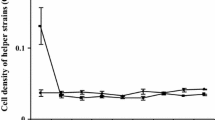Abstract
A novel two-helper-strain co-culture system (TSCS) was developed to enhance 2-keto-l-gulonic acid (2-KLG) productivity for vitamin C production. Bacillus megaterium and B. cereus (with a seeding culture ratio of 1:3, v/v), used as helper strains, increased the 2-KLG yield using Ketogulonigenium vulgare compared to the conventional one-helper-strain (either B. cereus or B. megaterium) co-culture system (OSCS). After 45 h cultivation, 2-KLG concentration in the TSCS (69 g l−1) increased by 8.9 and 7 % over that of the OSCS (B. cereus: 63.4 g l−1; B. megaterium: 64.5 g l−1). The fermentation period of TSCS was 4 h shorter than that of OSCS (B. cereus). The increased cell numbers of K. vulgare stimulated by the two helper strains possibly explain the enhanced 2-KLG yield. The results imply that TSCS is a viable method for enhancing industrial production of 2-KLG.


Similar content being viewed by others
References
Bremus C, Herrmann U, Bringer-Meyer S, Sahm H (2006) The use of microorganisms in l-ascorbic acid production. J Biotechnol 124:196–205
Feng S, Zhang Z, Zhang CG, Zhang ZZ (2000) Effect of B. megaterium on Gluconobacter oxydans in mixed culture. Chin J Appl Ecol 11:119–122 (In Chinese)
Jiao YH, Zhang WC, Xie L, Yuan HJ, Chen MX (2002) Effects of Bacillus cereus on Gluconobacter oxydans in vitamin C fermentation process. Microbiology 29:35–38 (In Chinese)
Liu LM, Li Y, Zhang J, Zhou ZM, Liu J, Li XM, Zhou JW, Du GC, Wang L, Chen J (2011a) Complete genome sequence of the industrial strain Ketogulonicigenium vulgare WSH-001. J Bacteriol 193:6108–6109
Liu LM, Chen KJ, Zhang J, Liu J, Chen J (2011b) Gelatin enhances 2-keto-l-gulonic acid production based on Ketogulonigenium vulgare genome annotation. J Biotechnol 156:182–187
Ma Q, Zhou J, Zhang WW, Meng XX, Sun JW, Yuan JY (2011) Integrated proteomic and metabolomic analysis of an artificial microbial community for two-step production of vitamin C. PLoS ONE 6:1–9
Ning WZ, Tao ZX, Wing CH, Wang SH, Yan ZZ, Yin GL (1988) Fermentation process for producing 2-keto-l-gulonic acid. EP Patent 0278447A2
Park YM, Choi ES, Rhee SK (1994) Effect of toluene-permeabilization on oxidation of d-sorbitol to l-sorbose by Gluconobacter suboxydans cells immobilized in calcium alginate. Biotechnol Lett 16:345–348
Stefanova S, Koseva M, Tepavicharova I, Beschkov V (1987) l-Sorbose production by cells of the strain Gluconobacter suboxydans entrapped in a polyacrylamide gel. Biotechnol Lett 9:475–477
Urbance JW, Bratina BJ, Stoddard SF, Schmidt TM (2001) Taxonomic characterization of Ketogulonigenium vulgare gen. nov., sp. nov. and Ketogulonigenium robustum sp. nov., which oxidize l-sorbose to 2-keto-l-gulonic acid. Int J Syst Evol Microbiol 51:1059–1070
Wei DZ, Yuan WK, Yin GL, Yuan ZY, Chen MH (1992) Studies on kinetic model of vitamin C two-step fermentation process. Chin J Biotechnol 8:277–282 (In Chinese)
Xu A, Yao J, Yu L, Lv S, Wang J, Yan B, Yu Z (2004) Mutation of Gluconobacter oxydans and B. megaterium in a two-step process of l-ascorbic acid manufacture by ion beam. J Appl Microbiol 96:1317–1323
Yin GL, Tao ZX, Yu LH, Wang DS (1980) Studies on the production of vitamin C precursor—2-keto-l-gulonic acid from l-sorbose by fermentationI. Isolation, screening and identification of 2-keto-l-gulonic acid producing bacteria. Acta Microbiolog Sin 20:246–251 (In Chinese)
Yin GL, He JM, Ren SX, Song Q (1997) Production of vitamin C precursor-2-keto-l-gulonic acid from l-sorbose by a novel bacterial component system of SCB329-SCB933. J Ind Microbiol 27:1–7 (In Chinese)
Zhang J, Liu J, Shi ZP, Liu LM, Chen J (2010) Manipulation of B. megaterium growth for efficient 2-KLG production by K. vulgare. Process Biochem 45:602–606
Zhou J, Ma Q, Yi H, Wang LL, Hao S, Yuan YJ (2011) Metabolome profiling reveals metabolic cooperation between Bacillus megaterium and Ketogulonicigenium vulgare during induced swarm motility. Appl Environ Microbiol 77:7023–7030
Zhu YB, Liu J, Du GC, Zhou JW, Chen J (2011) Sporulation and spore stability of Bacillus megaterium enhance Ketogulonigenium vulgare propagation and 2-keto-l-gulonic acid biosynthesis. Bioresour Technol 107:399–404
Acknowledgments
This research was financially supported by the Program of National Key New Drug Creation of China (No. 2011ZX09203-001-14).
Author information
Authors and Affiliations
Corresponding author
Additional information
Mandlaa and Weichao Yang have contributed equally to this work.
Rights and permissions
About this article
Cite this article
Mandlaa, Yang, W., Han, L. et al. Two-helper-strain co-culture system: a novel method for enhancement of 2-keto-l-gulonic acid production. Biotechnol Lett 35, 1853–1857 (2013). https://doi.org/10.1007/s10529-013-1292-5
Received:
Accepted:
Published:
Issue Date:
DOI: https://doi.org/10.1007/s10529-013-1292-5




